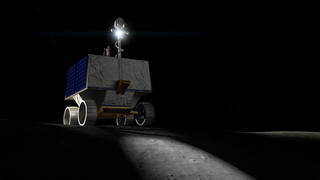Innovative Lunar Rover VIPER to map water ice on the Moon
- October 22, 2020
- Posted by: Lyn Wilson
- Category: Corporate, Engineering, Research Papers, Technology & Innovation, Water Issues, North America

NASA’s Artemis program begins a new era where robots and humans working together will push the boundaries of what’s possible in space exploration. Under the Artemis program the first woman and next man are aiming to land at the South Pole of the Moon in 2024.
NASA is sending a mobile robot to the South Pole of the Moon to obtain a detailed view of the location and concentration of water ice in the region and for the first time in history will actually sample the water ice there.
Planned for delivery to the lunar surface in December 2022,NASA’s Volatiles Investigating Polar Exploration Rover (VIPER) will collect about 100 days of data that will be used to inform the first global water resource maps of the Moon.
VIPER is a mobile robot that will be programmed to wander around the Moon’s South Pole looking for water ice. Its mission will give us surface-level detail of where the water is and how much is available for us to use.
“The key to living on the Moon is water – the same as here on Earth,” said Daniel Andrews, the project manager of the VIPER mission and director of engineering at NASA’s Ames Research Center in Silicon Valley.
He also added:
“Since the confirmation of lunar water-ice ten years ago, the question now is if the Moon could really contain the amount of resources we need to live off-world. This rover will help us answer the many questions we have about where the water is, and how much there is for us to use.”
If there are significant results from this research it will bring NASA, in collaboration with commercial and international partners, a step closer to its ultimate ambition of a sustainable, long-term presence on the Moon paving the way to eventually explore Mars and beyond.
The lunar rover VIPER is roughly the size of a golf cart and will be programmed to roam over several miles of the region. VIPER will employ four of its science instruments – including a 1-meter drill to sample a variety of soil environments.
The rover will collect data on different kinds of soil environments affected by light and temperature – those in complete darkness, occasional light and in direct sunlight. By collecting data on the amount of water and other materials in each, NASA can map out where else water likely lies across the Moon.
Scientists had long considered the lunar poles as promising spots to find water ice – a resource of direct value for humans that could provide oxygen to breathe and hydrogen and oxygen to fuel future landers and rockets.
In 2009, NASA crashed a rocket into a large crater near the South Pole and directly detected the presence of water ice. Data from this mission and other orbiters have confirmed that the Moon has reservoirs of water ice, potentially amounting to millions of tons.
VIPER is part of the Lunar Discovery and Exploration Program managed by the Science Mission Directorate at NASA Headquarters. Ames is managing the rover project, leading the mission’s science, systems engineering, real-time rover surface operations and software development.
The hardware for the rover is being designed by the Johnson Space Center, while the instruments are provided by Ames, Kennedy, and commercial partner, Honeybee Robotics.
The spacecraft lander and launch vehicle that will deliver VIPER to the surface of the Moon, will be provided through NASA’s Commercial Lunar Payload Services (CLPS) contract, delivering science and technology payloads to and near the Moon.
To read more click here: www.nasa.gov/feature/new-viper-lunar-rover-to-map-water-ice-on-the-moon
